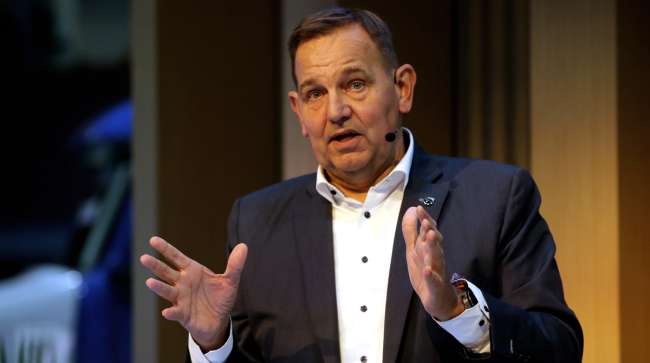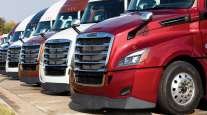Staff Reporter
Volvo Trucks Pushes Ahead With Electric Truck Goals

[Stay on top of transportation news: Get TTNews in your inbox.]
NASHVILLE, Tenn. — Volvo Trucks North America President Peter Voorhoeve reaffirmed Oct. 13 his commitment to lowering emissions with electric trucks even amid a slowing market.
The Volvo VNR Electric was designed for regional-haul and distribution fleets when it was introduced in December 2018. The truck manufacturer went on to develop and pilot the truck before officially launching it in North America in November 2020. It is also planning to introduce an electric version of its longhaul VNL late next year.
“There is a question about speed of development,” Voorhoeve told Transport Topics. “We have the VNR Electric; we have 600 of those trucks on the road. We’re leading the market, but we’re leading a very small segment. So it’s going slower than what I planned. That doesn’t mean that we should stop then or something like that.”
VTNA set up plastic mock-ups of some of its then-concept trucks in 2019. That included the VNR Electric and an earlier concept for an autonomous truck known as Vera. Voorhoeve recalled those displays and the work in the years since that led to workable models. It was driven by internal discussions asking where this development goes from here.
McLeod Software CEO Tom McLeod explores the potential for artificial intelligence to boost efficiency and build resilience. Tune in above or by going to RoadSigns.ttnews.com.
“This will happen; it just is going to take more time,” Voorhoeve said. “So whilst we are still working on the VNR Electric, then we launched the all-new VNL, which, by the way, also has a big sustainability goal — 10% better fuels and 10% better return for the carrier. But it’s also 10% better for the climate, because you have less emissions, both NOx and CO2. I think we have all the different prongs ready, and now it’s a matter of determining where do we need to accelerate, where do we need to slow down, because ultimately, the customer will tell us.”
VTNA essentially has positioned itself to be prepared for the different ways the market may evolve around lower emissions by working in these different areas. This allows customers who aren’t ready to transition into electromobility to still lower their emissions while creating a hedge for the different ways the market could change.
Want more news? Listen to today's daily briefing above or go here for more info
“We have all the components in place, including a new factory,” Voorhoeve said. “Because we know that in 2026, the market will be stronger. We know that in 2026, the demand will be higher than the industry capacity. We’re not building a factory for that year, by the way. We’re building that factory in order to balance our capacity in a better way so that we can better react to upswings and downswings in the market. It will help us with our logistical footprint. So that factory will be put down there for long-term objectives.”
Voorhoeve added that it’s not just having the ability to build more trucks but also the ability to handle regulations going forward. He also pointed out that this development will put the company in a good position for when the equipment market starts picking up more.
“I’m convinced that when we say that the new truck was designed to change everything, I think it was also designed to change our position in the market,” Voorhoeve said. “I strongly believe that the value that we bring will be attractive to many more customers than what we have today.”






